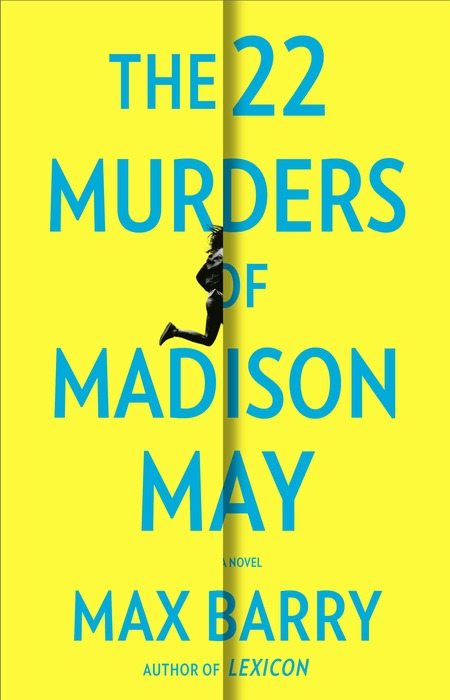While it’s not universally true, a great many novels about the multiverse come with a whimsical, wondrous edge, the idea that while there might be dangers aplenty in alternate realities, there is still an alluring sense of the different and the exciting.
None of that exists in The 22 Murders of Madison May by Max Barry (Providence), a novel that, in spirit at least, has a great deal in common with Doors of Sleep by Tim Pratt, where menace and dread are for more likely to hide on the other side of the tissue thin behind realities than wonder and awe-inspiring difference.
In this breathtakingly readable exploration of the endless world of multiverses, which compels you to turn the page while instilling a reasonable fear of what you will find there, The 22 Murders of Madison May takes its protagonist, newspaper reporter Felicity Staples, across a broad swathe of world eerily like but not quite her own in pursuit of sociopathic serial killer Clayton Hors who is intent on winning the heart of aspiring actor Madison May in the cruellest and most deadly of ways.
The narrative, which is pell-mell in its intensity but beautifully human in its focus (so, action with heart), is thus suitably, scarily chilling with Felicity having to simultaneously grapple with shifting realities while doing her best, with the aid of a mysteriously semi-benevolent group of multiverse travellers, to save the life of the remaining Madison Mays of which there are an near-infinite multitude.
“He held something out to her: a dull egg the color of old metal. And she wasn’t going to take it, of course, but her hands instinctively came up to repel him, and she was momentarily distracted, thinking, What is that, some kind of weapon? and he seized her wrist.
‘Hold it,’ Hugo said. He pressed the egg into her palm. Then he shoved her off the platform.” (P. 50)
What makes The 22 Murders of Madison May so brilliantly unsettling in the very best of ways is the way it takes it time to investigate how these leaps from one dimension to another affect Felicity.
The jumps Felicity undergoes are so acutely unnerving precisely because the differences are usually not that massive, slight tweaks here and there that together add up to a yawning chasm of reality-to-reality changes which Felicity eventually uses to her advantage but not before she finds herself wondering where her second cat is or trying to work what kind of person her boyfriend Gavin is in this reality.
It’s taxing and Barry does a great job of exploring how these small but noticeable differences are a massive mind f**k for Felicity who clings to some constants such as her job as a reporter, the presence of Gavin and relative uniformity of New York as a city.
Fortunately, Felicity is a malleable person, and while she struggles at first to get her head around what’s happening, she adapts reasonably quickly, partly because her jumps are one-way and she can’t go back even if she wants to, but because her overriding mission becomes to save Madison May, who has been killed many times before and could yet be killed again.
As premises for a thriller ride across the multiverse go, it’s enormously, scintillatingly imaginative, a race to the finish line that comes with as many humanity as it does ceaseless, heart-stopping momentum.
One thing that remains constant throughout The 22 Murders of Madison May is how dark the human psyche can be, no matter what a particular reality may look like.
Even those who are ostensibly the good guys and traverse the multiverse, so they declare, to make it a better place, are teetering on the edge of self-serving narcissism.
They are not bad people as such, and they do recognise the danger that twisted loose cannon Clayton Hors poses to Madison May and the multiverse as a whole, but they seem to be very little to stop the bloody trail of dead Madisons.
Only Felicity, with some help from one of this group of explorers, seems committed to protecting the titular young woman who we meet in a variety of her guises from real estate agent to aspiring actor to Hollywood sensation on the rise.
Once she adjusts to her ever-so-slightly changing worlds, Felicity become an unstoppable force, determined to stop Clayton Hors in his murderous tracks and to give Madison a chance to become what 21 of her predecessors were denied the chance to do – fulfill her true potential.
It’s here that the The 22 Murders of Madison May is a fascinating examination of “what ifs”.
While we are party to the various incarnations of Felicity Staples, she is by and large a set quantity, a journalist in her thirties with a boyfriend who, while still ambitious, has largely got a life that works.
“Hands seized her. Abruptly Hugo was upon her, and Felicity, as if they really had been stalking her. They called to her, but there was a rushing in her ears that drowned them out. She saw Felicity mouth her name, Maddie, Maddie, her eyes huge and anguished. She felt bad, as if she’d let Felicity down in some way. Whatever Felicity’s secret mission had been, whether it involved codes or Russians or something else altogether, it had failed somehow. I’m sorry. Maddie tried to say. The buzzing became a roaring and the street dwindled and fell away.” (P. 206)
By way of contrast, and this cuts to the heart of why Clayton Hors sociopathic mission is so brutally horrific, Madison May is 22, still sorting out who she might be, possessed of enough talent and street smarts to be pretty much anything.
That Hors keeps stopping these possible evolutions in their tracks amplifies the tragedy of the ongoing murders of Madison May all the more, the loss fell all the more profoundly because we actually get to bear witness to all the very people Madison could have become.
For that reason alone, The 22 Murders of Madison May cuts to the heart, its inventive tale of life across the multiverse an incisively affecting elucidation of the endless possibilities that await all of us if we are given the opportunity to pursue them.
Madison, well at least 21 variants of her, sadly are not, and The 22 Murders of Madison May thrives as a gripping piece of storytelling which not only features a compelling race against time to see justice done but a vibrant evocation of humanity, its darkness and its light, its consistency and change but most of all, its ability to change and morph and grow no matter where it is.
It is that last aspect that lends so many resonance and heart to this supremely clever piece of storytelling which never stops drawing you in or making you ponder the great “what ifs” which never stop speaking to us, no matter what kind of reality we find ourselves in.

